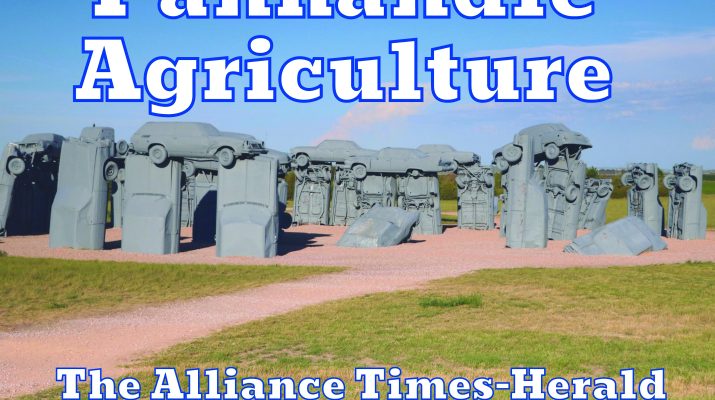By Cara Pesek
IANR Media
The University of Nebraska held a ribbon-cutting ceremony June 27 marking the completion of a feedlot research, teaching and extension center. The new facility, located at the Eastern Nebraska Research, Extension and Education Center near Mead, Nebraska, will pave the way for world-class research projects and teaching and extension opportunities in a commercial-scale, state-of-the-art feedlot.
The facility will be named the Klosterman Feedlot Innovation Center in honor of the late John Klosterman and his wife, Beth, of David City, Nebraska. The University of Nebraska Board of Regents is expected to formally approve the facility’s name in August.
Beth Klosterman is a University of Nebraska Foundation trustee, and both she and John have been longtime supporters of both the university and its Institute of Agriculture and Natural Resources. The Klosterman family represents five generations of cattle feeding in Nebraska.
“Our dad was proud to be part of Nebraska’s agriculture industry and passionate about connecting with others who shared his commitment to advancing livestock production and natural resources stewardship,” said Meg Klosterman Kester, who along with her brother, Jack, spoke on behalf of the Klosterman family during the ribbon cutting. “Our dad knew the power of collaboration, and he would be so proud to be part of the incredible group celebrating the opening of the Klosterman Feedlot Innovation Center here today. As a family, we are very proud and thankful for the example our parents provided and the legacy they have created.”
The $7.2 million facility received $5.5 million in private support through the University of Nebraska Foundation. In addition to the Klostermans, other lead donors to the project include JBS USA, Greater Omaha Packing Co. Inc., Farm Credit Services of America and Dennis and Glenda Boesiger.
“The Klosterman Feedlot Innovation Center will support the university’s land-grant mission and advancement of our state’s largest industry — agriculture,” Rodney Bennett, chancellor of the University of Nebraska–Lincoln, said. “This public-private partnership that led to the facility will allow faculty and students to take part in groundbreaking beef research, and at the same time allow producers and industry partners to see how new and emerging technologies perform in a commercial scale feedlot. The university is so grateful for the generous contributions of private donors, including the leadership of John and Beth Klosterman, that have made today possible.”
The new facility is among the largest research feedlots in the world and is designed to present unique opportunities for teaching, outreach and public-private partnerships. The center includes commercial-scale open air and covered pens, allowing researchers to improve the performance and environmental impact of cattle in varied settings. It also boasts a 240-head feeding facility that will allow researchers to use precision techniques to study the outcomes of various feeding protocols, measure emissions and study the various uses for precision feeding technology already on the market.
The center allows for expanded research of the impact of low-stress animal handling and increased emphasis on animal welfare, with state-of-the-art equipment donated by Daniels Manufacturing and Arrowquip, two leading animal handling equipment companies. An enclosed classroom will give students hands-on experience and allow for training opportunities for Nebraska’s beef industry workforce.
The facility will also serve as an innovation laboratory, which industry partners, ag-tech startups, producers and others can use as a proving ground for new products, said Mike Boehm, Harlan Vice Chancellor for IANR and NU vice president. Numerous industry partners have already made in-kind donations of equipment, and in the future, the center will provide opportunities for ag-tech companies, equipment manufacturers and other companies to test new products in a commercial-scale facility, as well as for cattle feeders to observe how these products work.
“The Klosterman Feedlot Innovation Center is another example of where ag innovation meets Nebraska’s growing bioeconomy,” Boehm said. “The center is designed to inspire students, faculty, cattle feeders, industry partners and startups to ask what is possible. It’s designed to spur collaboration, pressure-test ideas and ultimately put new products in the hands of producers. It’s designed to continue Nebraska’s legacy of innovation when it comes to beef research. It’s designed to ensure that what happens next in beef production happens first in Nebraska.”
The new center will be a key component of the university’s Beef Innovation Hub, which aims to advance, support and communicate continuous improvement of beef production, economic vitality and natural resources stewardship through innovative research, education and extension.
Cattle will arrive in the facility later this summer, with research projects, classes, tours and other learning opportunities to be offered shortly after.
Gifts to the project support Only in Nebraska: A Campaign for Our University’s Future, a historic effort to raise $3 billion from 150,000 unique benefactors to support the University of Nebraska.
“I want to express my sincere gratitude to John and Beth Klosterman and the many other donors who generously supported the Klosterman Feedlot Innovation Center,” said Brian F. Hastings, president and chief executive officer of the University of Nebraska Foundation. “This state-of-the-art facility will support the Nebraska beef industry, a cornerstone of our state’s economy, by paving the way for world-class research, providing hands-on training for students and giving beef industry partners a testbed for new and emerging technologies.”
Additional philanthropic support came from the Terry Klopfenstein Fund, which included gifts from 53 alumni, colleagues and industry partners who knew and worked with the late Terry Klopfenstein. Klopfenstein was a longtime leader of the university’s ruminant nutrition program and a pioneer in using byproducts from the ethanol and sweetener industries to supplement cattle feeding. One of the buildings in the complex will be named the Terry Klopfenstein Feed Technology Center, pending formal approval.
Also providing funds was the August N. Christenson ARDC Excellence Fund, made possible by a planned gift from the late August Christenson, who grew up on his family’s farm in Saunders County and dedicated his career to the Standard Chemical Manufacturing Co., a livestock feed and supply firm in Omaha.

